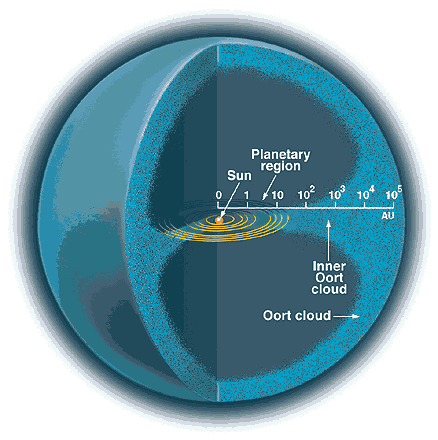
Comets also are cosmic debris, probably planetesimals that originally resided in the vicinity of the orbits of Uranus and Neptune rather than in the warmer regions of the asteroid belt. Thus, the nuclei of comets are icy balls of frozen water, methane, and ammonia, mixed with small pieces of rock and dust, rather than the largely volatile-free stones and irons that typify asteroids. In the most popular theory, icy planetesimals in the primitive solar nebula that wandered close to Uranus or Neptune but not close enough to be captured by them were flung to great distances from the Sun, some to be lost from the solar system while others populated what was to become a great cloud of cometary bodies, perhaps 10 trillion in number. Such a cloud was first hypothesized by the Dutch astronomer Jan Hendrik Oort.

In the original version of the theory, the Oort cloud extended tens of thousands of times farther from the Sun than the Earth, a significant fraction of the way to the nearest stars. Random encounters with passing stars would periodically throw some of the comets into new orbits, plunging them back toward the heart of the solar system. As a comet nears the Sun, the ices begin to evaporate, loosening the trapped dust and forming a large coma that completely surrounds the small nucleus, which is the ultimate source of all the material. The solar wind blows back the evaporating gas into an ion tail, and radiation pressure pushes back the small particulate solids into a dust tail. Each solid particle is now an independently orbiting satellite of the Sun, and the accumulation of countless such passages by many comets contributes to the total quantity of dust particles and micrometeoroids found in interplanetary space.
The total mass contained in all the comets is highly uncertain. Modern estimates range from 1 to 100 Earth masses. Part of the uncertainty concerns the reality of a hypothesized massive "inner Oort cloud" -- or "Kuiper belt" (if the distribution is flattened)--of comets that would exist at distances from the Sun 40 to 10,000 times that of the orbit of the Earth. At such locations, the comets would not be much perturbed by typical passing stars nor by the gravity of the planets of the solar system, and the comets could reside in the inner cloud or belt for long periods of time without detection. It has been speculated, however, that a rare close passage by another star (possibly an undetected companion of the Sun) may send a shower of such comets streaming toward the inner solar system. If enough large cometary nuclei in such showers happen to strike the Earth, the clouds of dust and ash that they would raise might be sufficient to trigger mass biological extinctions. An event of this kind appears especially promising for explaining the relatively sudden disappearance of the dinosaurs from the Earth.
Excerpt from the Encyclopedia Britannica without permission.